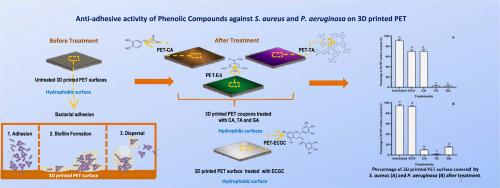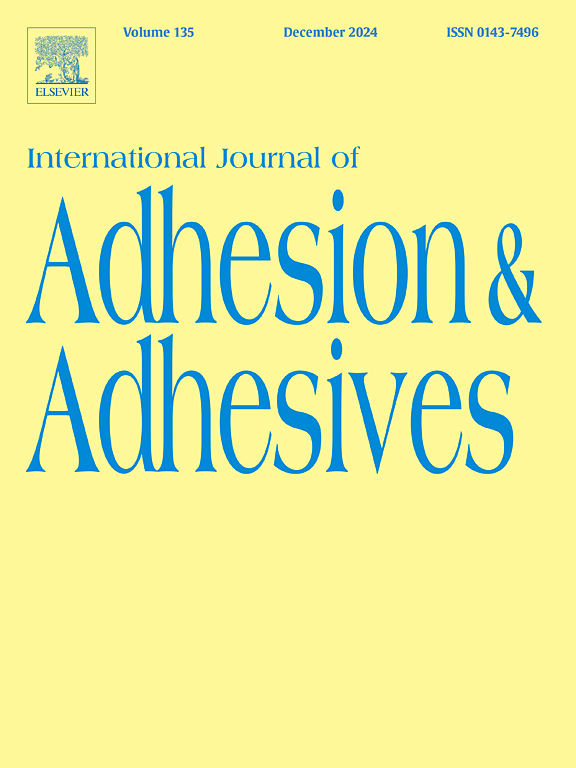增强三维打印 PET 的理化特性,防止细菌附着:基于酚类化合物的方法
IF 3.2
3区 材料科学
Q2 ENGINEERING, CHEMICAL
International Journal of Adhesion and Adhesives
Pub Date : 2024-10-19
DOI:10.1016/j.ijadhadh.2024.103847
引用次数: 0
摘要
聚对苯二甲酸乙二醇酯(PET)具有生物相容性、高均匀性和机械强度等优异特性,因此已成为医疗保健领域,特别是医疗器械制造领域广泛使用的一种多功能聚合物材料。然而,在医疗应用中,PET 对细菌粘附的敏感性仍然是一个严峻的挑战,有可能导致患者出现严重的并发症。在这项研究中,我们使用接触角和扫描电子显微镜(SEM)技术评估了各种酚类化合物(包括没食子酸(GA)、单宁酸(TA)、咖啡酸(CA)和表没食子儿茶素没食子酸酯(EGCG))在防止金黄色葡萄球菌和绿脓杆菌粘附到 3D 打印 PET 表面方面的效果。结果表明,最初疏水的 PET(θw = 75.7 ± 0.56°,ΔGiwi = -52.17 mJ/m2)在经过 TA、GA 和 CA 处理后变得亲水,从而增强了其理化特性。此外,GA 对金黄色葡萄球菌有显著的抗粘附效果,抑制率达 97.4%,而 TA 对绿脓杆菌的抑制率则很高(98.5%)。相比之下,PET 经 EGCG 处理后仍具有疏水性,其抗粘附功效有限,金黄色葡萄球菌和铜绿假单胞菌的覆盖率分别为 70.15% 和 92.7%。这些发现有助于开发可持续的医疗器械防粘表面。本文章由计算机程序翻译,如有差异,请以英文原文为准。

Enhancing 3D printed PET physicochemical properties to prevent bacterial adhesion: Phenolic compound-based approach
Polyethylene terephthalate (PET) has emerged as a versatile and widely used polymeric material in the healthcare sector, particularly for medical device manufacturing, owing to its exceptional properties such as biocompatibility, high uniformity, and mechanical strength. However, the susceptibility of PET to bacterial adhesion remains a critical challenge in medical applications, potentially leading to serious complications for patients. In this study, we assessed, using the contact angle and scanning electron microscopy (SEM) techniques, the effectiveness of various phenolic compounds, including gallic acid (GA), tannic acid (TA), caffeic acid (CA) and epigallocatechin gallate (EGCG), in preventing the adhesion of Staphylococcus aureus and Pseudomonas aeruginosa to 3D printed PET surfaces. The results revealed that PET, initially hydrophobic (θw = 75.7 ± 0.56° and ΔGiwi = −52.17 mJ/m2), became hydrophilic after treatment with TA, GA and CA, enhancing its physicochemical properties. Additionally, GA demonstrated remarkable anti-adhesive efficacy against S.aureus with inhibition percentage of 97.4 %, whereas TA exhibited a high inhibition rate against P.aeruginosa (98.5 %). In contrast, PET remained qualitatively hydrophobic after treatment with EGCG, which showed limited anti-adhesive efficacy with a percentage of coverage by S.aureus and P.aeruginosa of 70.15 and 92.7 %, respectively. These findings contribute to the development of sustainable anti-adhesive surfaces for medical devices.
求助全文
通过发布文献求助,成功后即可免费获取论文全文。
去求助
来源期刊

International Journal of Adhesion and Adhesives
工程技术-材料科学:综合
CiteScore
6.90
自引率
8.80%
发文量
200
审稿时长
8.3 months
期刊介绍:
The International Journal of Adhesion and Adhesives draws together the many aspects of the science and technology of adhesive materials, from fundamental research and development work to industrial applications. Subject areas covered include: interfacial interactions, surface chemistry, methods of testing, accumulation of test data on physical and mechanical properties, environmental effects, new adhesive materials, sealants, design of bonded joints, and manufacturing technology.
 求助内容:
求助内容: 应助结果提醒方式:
应助结果提醒方式:


